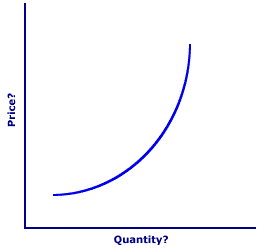
|
|
LONG-RUN ADJUSTMENT, PERFECT COMPETITION: The combined adjustment of a perfectly competitive industry and of each firm in the industry to an equilibrium condition that eliminates all economic profits and losses, while each firm selects a factor size that maximizes profit. This adjustment process involves two parts. One is the adjustment of each perfectly competitive firm to the appropriate factory size that maximizes long-run profit. The other is the entry of firms into the industry or exit of firms out of the industry, to eliminated economic profits or economic losses. The end result of this long-run adjustment is a multi-faceted equilibrium condition: P = AR = MR = MC = LRMC = ATC = LRAC
Visit the GLOSS*arama
|
|


|

|
                           SHORT-RUN AGGREGATE SUPPLY AND MARKET SUPPLY: The short-run aggregate supply curve, or SRAS curve, has similarities to, but differences from, the standard market supply curve. Both are positively sloped. Both relate price and quantity. However, the market supply curve is positively sloped due to the law of diminishing marginal returns and the short-run aggregate supply curve is positively-sloped due to inflexible prices, the pool of natural unemployment, and imbalances in real resource prices. | Two Similar Curves |  |
To illustrate the specific short-run aggregate supply and market supply curve similarities and differences consider the graph of a positively sloped curve displayed here. Is this a market supply curve or an short-run aggregate supply curve? A cursory analysis suggests that it could be either.To reveal the similarities between the both curves, click the [Market Supply] and [Aggregate Supply] buttons. Doing so illustrates that both curves are positively sloped, with each virtually overlaying the other. Consider the differences between these two curves. - First, note that for the market supply curve, the vertical axis measures supply price and the horizontal axis measures quantity supplied. For the short-run aggregate supply curve, however, the vertical axis measures the price level (GDP price deflator) and the horizontal axis measures real production (real GDP).
- Second, the positive slope of the market curve reflects the law of supply and is attributable to the law of diminishing marginal returns. In contrast, the positive slope of the short-run aggregate supply curve is attributable to: (1) inflexible resource prices that often makes it easier to reduce aggregate real production and resource employment when the price level falls, (2) the pool of natural unemployment, consisting of frictional and structural unemployment, that can be used temporarily to increase aggregate real production when the price level rises, and (3) imbalances in the purchasing power of resource prices that can temporarily entice resource owners to produce more or less aggregate real production than they would at full employment. Similar, but different.
Most notable, the differences between market supply and short-run aggregate supply means that it is not possible to merely add up, or aggregate, the market supply curves for the thousands of goods produced in the economy to derive the short-run aggregate supply curve. The short-run aggregate supply curve dances to its own music and plays be its own set of rules.

Recommended Citation:SHORT-RUN AGGREGATE SUPPLY AND MARKET SUPPLY, AmosWEB Encyclonomic WEB*pedia, http://www.AmosWEB.com, AmosWEB LLC, 2000-2024. [Accessed: April 29, 2024].
Check Out These Related Terms... | | | | | |
Or For A Little Background... | | | | | | | | | | |
And For Further Study... | | | | | | | | | | |
Search Again?
Back to the WEB*pedia
|



|

|
|
In 1914, Ford paid workers who were age 22 or older $5 per day -- double the average wage offered by other car factories.
|

|
|
"Something in human nature causes us to start slacking off at our moment of greatest accomplishment. As you become successful, you will need a great deal of self-discipline not to lose your sense of balance, humility and commitment." -- H. Ross Perot
|

|
LME
London Metal Exchange
|

|
|
Tell us what you think about AmosWEB. Like what you see? Have suggestions for improvements? Let us know. Click the User Feedback link.
User Feedback
|


|


